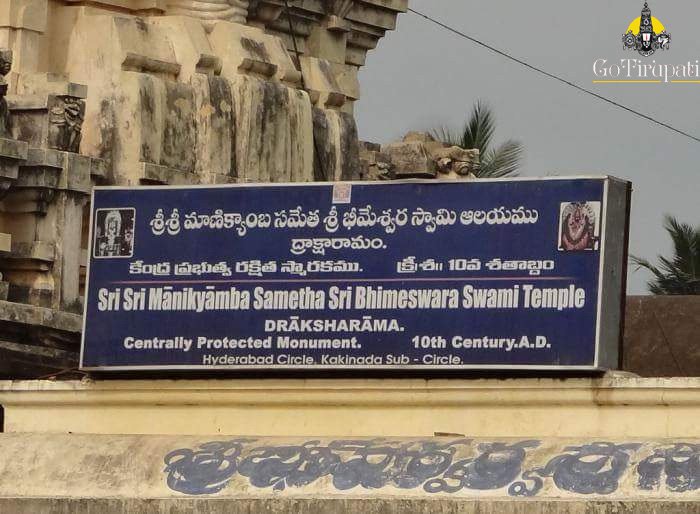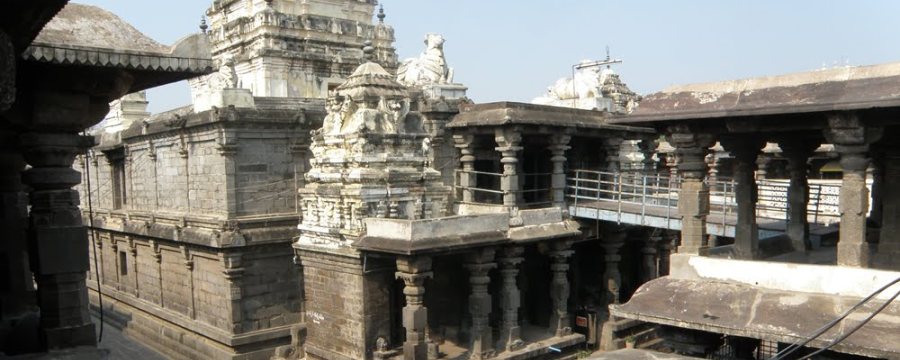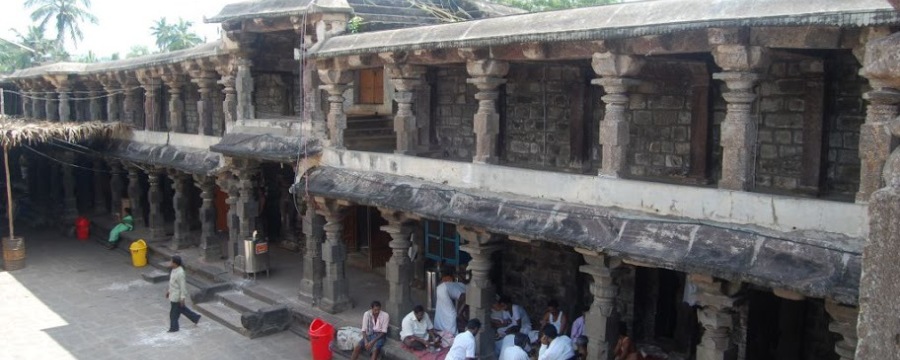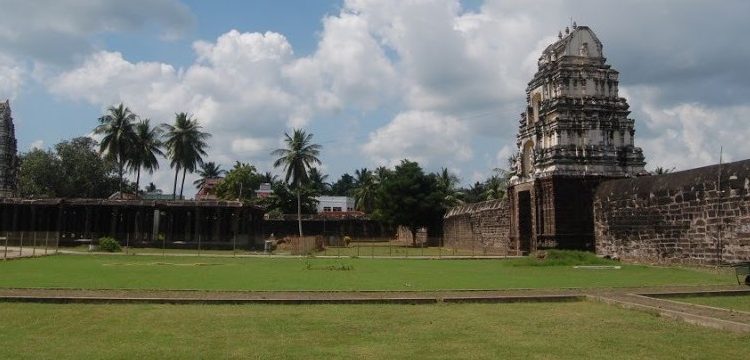Manikyamba Devi is the wife of Lord Bhimeswara Swamy. Lord Bhimeswara Swamy temple is one of the Pancharama kshetras and is considered as one of the Trilinga kshetras. Here there is a big temple of Lord Bhimeswara Swamy in many Prakaras. Manikyamaba Devi temple present in the inner circle of Lord Bhimeswara Swamy temple.
Shrine’s History
The history of this important pilgrimage place begins countless of years ago,in previous yugas , with the story of Lord Siva and the human incarnation of the Divine Mother known as Satī Devi. At times the Divine Mother, Sakti, has taken birth as a human being to reunite with and marry Lord Siva. Such was the case when Sati Devi was born into the family of a powerful but arrogant ruler, Daksha Prajapati.
The Prajapati despised Lord Siva. But despite her fathers staunch disapproval, Satī Devī eventually married Lord Siva. After their marriage, Daksha Prajapati travelled from North India to Drakṣhārāmam to perform a large ya jam, or fire ceremony, that has become known as Daksha Yajnam. Daksha invited the entire celestial realm, all of the Devatas were invited, with the exception of Lord Siva and Sati DevI. In an attempt to convince her father to accept Lord Siva as both her husband as well as a form of the Supreme Being,
Satī Devī left Lord Siva and attended Dakshas Yajnam. Tragedy soon followed when the Prajapati refused Satī Devī and her requests to welcome Lord Śiva. Daksha continued to insult the Lord and Sati Devi until enraged Sati Devi was driven to end her human existence by self-immolation. Upon witnessing this awful scene, the all-knowing Lord Siva descended to earth and mourned the loss of his eternal Love, the complement of his own Self in human form, Sati . Today, a portion of the remains of Goddess Satī still remain at Drsksharamam, and the other locations in the world where they are known as the Sakthi Pithas. It is worth noting that Draksharamam was earlier known as Daksharamam.
Sri Manikyamba Devī at Draksharamam ? One of the 18 Sakthi PIthas The portion of Sati Devi that exists in Daksaramam was installed by Lord Siva. Much later, about 1200 years ago, the Adi Sankaracarya visited this place and installed a powerful Sri Chakra here in the shrine of the Goddess. This extremely powerful form of Divine Mother is known as Manikyamba Devi and is one of the 18 recognised Sakti Pithas. Today the temple is under the shield of the Indian governments archaeological department. Neighbouring the Draksharamam Temple we can still see today the Daksha Prajapatis Homa Kunda where Satī Devī left her body. Now the homa kunda retains water and has become a small tank. An effigy of the Goddess Sati has been enshrined in the centre and small temple exists adjacent to the homa kunda

Legends Associated with This Shrine
Dakshaprajapati, father of Goddess Parvathi arranged for a yagna and did not invite Lord Shivas family. But, Goddess Sakthi took her own invitation and got criticised by her father and sacrificed herself in the same fire which led Lord Shiva to create Lord Veerabhadra with his hair to destroy the yagna. After the destruction, Lord Shiva had done rudrataandavam carrying his wifes dead body in anger. Lord Vishnu had used his Sudarshan to cut Sati Devis dead body into 108 pieces to make Lord Shiva peaceful. The places where the parts of Sati Devi had fallen are called Shakthi Peetams holy places of Goddess, one among them is Draksharamam and the goddess here is named as Manikyamba. Once upon a time, demon Tarakasura had his tapas and booned by Lord Shiva with his AtmaLinga. With this proud, Tarakasura had committed many sins against devas. Due to this, all devas went to make Goddess Parvathi marriage with Lord Shiva in order to kill Tarakasura by giving birth to Lord Shanmukha. Shanmukha went for a battle against Tarakasura. On Lord Shivas suggestion, Shanmukha destroyed at Malinga in Tarakasuras neck and killed him. The pieces of at Malinga had fallen at 5 holy places in Andhra Pradesh which are popular known as Pancharamams. One is Amareshwara installed by Lord Indra in Amaravathi, the second is Someswara installed by Lord Chandra in Bheemavaram, the third is Ksheera Ramalingeswara installed by Lord Rama in Palakollu, the fourth is Kumara Rama Bheemeswara installed by Shanmukha in samrlakota and the fifth one is Bheemeswara who had shown himself in Drakshramam. In order to purify the piece fallen in Drakshramam, the sages requested River Godavari but the Godavari had responded late which made Lord Shiva to emerge himself in Draksharamam. River Godavari came here with the request of Saptarshi hence called SapthaGodavari which is located on the east to the temple as Pushkarini. On a day, Lord Shiva tested Sage Vyasa by not getting him any food by donation in Kasi. Sage Vyasa lost his patience on his hungry tried cursing Kasi but Goddess Annapurna had provided food to Vyasa and his disciples and Lord Shiva had ordered him to leave kasi. The goddess had suggested Drakshramam, an equivalent of Kasi in order to spend his remaining life. Vyasa Treated it as Dakshina Kasi and devoted to Lord Shiva which is also named as Vyasa Kasi. Lord Shiva preached vyasa that Kasi is meant for the liberation of the soul but not for a luxury living while Draksharamam is meant for both which is also stated in Bheema khanda.

Architectural Relevance of This Shrine
According to the inscription at Pithapuram, it is very clear that the temple of Kumaram Chalukya Bhimesvara was constructed by the famous Eastern Chalukya king Chalukya Bhima-I towards the end of the 9th century AD and the presiding god Siva, in the form of tall Sivalinga, was named after the monarch as Chalukya Bhimesvara. The inscription states that Chalukya Bhima, the son of Vikramaditya having been victorious in three hundred and sixty battles ruled the earth for thirty years. The Bhimesvara temple at Samalkot is similar in architecture to that of the Bhimesvara temple at Daksharama. The temple is surrounded by two prakara walls built of dressed sandstones. The outer prakara wall is pierced by gopura – entrance on all the four sides. The four gopura – dvaras have ardha – mandapas on either side. The inner enclosure wall is divided horizontally into two sections separated by a cornice. It has a two-storeyed pillared mandapa running all the inner side.

Shrine’s Map Location and How to Go There
By Road
Draksharamam is at 50 km distance from Rajahmundry. It is well connected by Road route. APSRTC maintaining many buses from various Depot from Kakinada(30 km), Vijayawada(200 km), Vishakapatnam(190 km)
By Rail
Nearest Railway station is Samarlakota and Kakinada which are at about 50 km and 30 km distance respectively.
By Air
Nearest Airports are at Rajahmundry, Vijayawada which is at about 50 km and 200 km distance respectively.
Shrine Timings
6.00AM to 7.00AM and night 7.00PM to 8.00PM Wednesdays: 6.00AM to 11.30AM and 3.00PM to 8.00PM Rest of the days: 6.00AM to 12 noon and 3.00PM to 8.00PM
Events Celebrated at This Shrine
Mahashivratri, Devi Navaratrulu , Kartika Masam, Dhanur Masam are the main festivals celebrated in this temple.
Extra Information About this Shrine
Attractions:- The temple is noted not only for its architectural beauty and historical importance but also for its sanctity and holiness and attracts pilgrims in thousands every year. Additional places of interest around Draksharama include Samalkot , Annavaram, Thalupulamma Thalli and Rajahmundry. Tourists better plan their stay either at Kakinada, Samalkot or Rajahmundry. Travellers can also make Rajahmundry as the centre place for their trip.













































